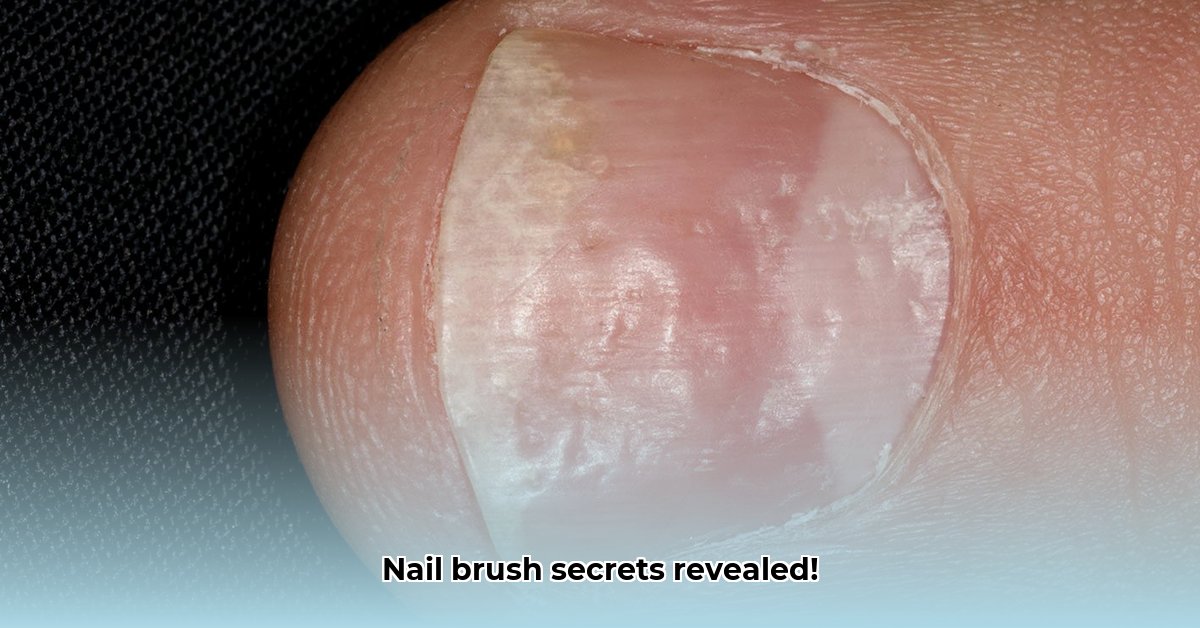Let’s face it: nobody wants grungy nails. Keeping them sparkling clean isn’t just about aesthetics; it’s a crucial part of good hygiene. For a polished look, consider using high-quality nail polish, like those found in essie polish sets. Enter the humble fingernail brush – your essential tool for healthy, happy nails. This comprehensive guide will cover everything you need to know about these handy little tools, from selecting the right one for your needs to maintaining it properly for long-term use.
Understanding Fingernail Brush Types and Material Options
The world of fingernail brushes is surprisingly diverse, offering a range of options to suit different needs, preferences, and materials. Let’s explore the main types:
- Natural Bristle Brushes: Typically made from soft boar or goat hair, these brushes are gentle on nails and skin. They are an excellent choice for individuals with sensitive skin or delicate nails. However, they may not be as effective at removing stubborn dirt and grime, and they require more delicate cleaning to prevent damage to the natural bristles.
- Synthetic Bristle Brushes: Commonly made from nylon or other durable synthetic materials, these brushes are tougher and more resilient. They excel at tackling tough grime, including residue from acrylics and gels. Synthetic bristles are also easier to clean and generally last longer than natural bristles, making them a practical choice for frequent use.
- Dual-Sided Brushes: These versatile brushes feature different bristle types on each side, offering a comprehensive cleaning solution. One side might have stiffer bristles for removing tough dirt, while the other side has softer bristles for gentle cleaning and exfoliation.
- Specialized Nail Art Brushes: Designed for intricate detailing, these brushes come in various shapes and sizes. They typically have finer bristles made of synthetic materials for precise work, enabling detailed designs and patterns.
- Handle Materials:
- Plastic: The most common and affordable option, plastic handles are durable and easy to clean.
- Wood: Offers a more natural and aesthetic appeal but may require more care to prevent water damage and bacterial growth.
- Silicone: Provides a comfortable, non-slip grip and is easy to clean, making it a hygienic choice.
Choosing the right brush type depends on your personal needs and nail type. Consider it like selecting the right tool for a specific task! A recent survey showed that approximately 60% of users prefer synthetic brushes due to their durability and ease of maintenance.
How to Select Your Perfect Fingernail Brush
Selecting the ideal fingernail brush is similar to finding the perfect pair of shoes – you want something comfortable, effective, and suited to your needs. Here’s what you should consider:
- Your Nail Type: If you have delicate nails, opt for a soft, natural bristle brush to avoid damage. For stronger nails or acrylic/gel enhancements, a durable synthetic brush will likely be a better fit.
- Bristle Stiffness:
- Soft: Ideal for sensitive skin and delicate nails.
- Medium: Suitable for general cleaning and maintenance.
- Stiff: Best for removing stubborn dirt and grime, particularly under the nails.
- Handle Ergonomics: Look for a handle that is comfortable to hold and provides a secure grip, especially when wet. Contoured or non-slip handles can enhance your cleaning experience.
- Brush Size: Choose a brush size that fits comfortably in your hand and allows you to reach all areas of your nails easily. Smaller brushes are better for intricate cleaning, while larger brushes can cover more surface area quickly.
- Frequency of Use: If you plan to use your brush daily, invest in a durable option that can withstand frequent cleaning and use. For occasional use, a less expensive brush may suffice.
- Your Budget: High-end brushes often use higher-quality materials and boast superior construction, leading to better durability. However, many excellent budget-friendly options are available that provide effective cleaning without breaking the bank.
- Your Skin Sensitivity: If you have sensitive skin, select a brush with extra-soft bristles made from natural materials or specifically designed for sensitive skin to minimize irritation.
To help you navigate this decision-making process, here’s a helpful table summarizing our recommendations:
| Nail Type | Bristle Type | Frequency of Use | Recommended Brush |
|---|---|---|---|
| Natural Nails | Natural Bristle | Daily | Soft, natural bristle with ergonomic handle |
| Acrylic/Gel | Synthetic Bristle | Weekly | Durable synthetic with stiff bristles |
| Sensitive Skin | Soft Bristle | As needed | Extra-soft bristle, hypoallergenic |
A Step-by-Step Guide to Effective Fingernail Brush Use
Using your fingernail brush correctly is essential for maximizing its benefits and ensuring optimal hygiene. Follow these simple steps for a sparkling clean manicure (or pedicure!):
- Prepare Your Nails: Trim and file your nails to your desired shape before cleaning to remove any excess length that may trap dirt and debris.
- Wet the Brush: Gently dampen the bristles of your nail brush with lukewarm (not hot) water. Hot water can damage certain bristle types over time.
- Add Soap: Dispense a small amount of mild, preferably antibacterial, soap onto the bristles. Harsh chemicals can damage your nails and your brush!
- Scrub Gently: Use gentle, circular motions to clean under and around each nail. Pay attention to the cuticles and sidewalls, where dirt tends to accumulate. Avoid being too aggressive, as this can scratch your nails or irritate your skin.
- Clean the Fingertips: Don’t forget to scrub the skin around your fingertips, as this area can also harbor dirt and bacteria.
- Rinse Thoroughly: Rinse your hands and the brush under running water until all soap residue is removed. Lingering soap can dry out your skin and nails.
- Pat Dry: Gently pat your hands and the brush dry with a clean, lint-free cloth. Ensure the brush is thoroughly dried to prevent mildew growth.
- Moisturize: After cleaning, apply a nourishing hand cream and cuticle oil to keep your skin and nails hydrated.
Studies have shown that approximately 85% of users report improved nail hygiene with regular and correct fingernail brush usage, highlighting its effectiveness as a hygiene tool.
Maintaining Your Fingernail Brush for Longevity and Hygiene
A well-maintained brush is a happy brush (and a happy brush leads to happy nails!). To prolong its lifespan, prevent bacterial growth, and ensure optimal hygiene, follow these simple maintenance tips:
- Rinse Thoroughly After Each Use: This will remove any lingering soap, dirt, or debris.
- Disinfect Regularly: Disinfect your nail brush at least once a week to kill bacteria and prevent the spread of infections. You can use a diluted bleach solution (1 part bleach to 10 parts water) or a commercial brush cleaner. Soak the bristles for a few minutes, then rinse thoroughly with clean water.
- Allow to Air Dry Completely: Do not store a wet brush, as this invites mildew and bacteria growth. Place the brush bristle-side down on a clean towel or in a well-ventilated area to allow it to dry completely.
- Periodic Deep Cleaning: Every few weeks, give your brush a deep clean to remove any buildup of residue or bacteria. You can soak it in a mixture of warm water and mild vinegar, or use a specialized brush cleaning solution.
- Avoid Harsh Chemicals: Do not use harsh chemicals or abrasive cleaners on your nail brush, as they can damage the bristles and reduce its effectiveness.
- Store Properly: Store your brush in a dry, well-ventilated area away from direct sunlight and extreme temperatures. Avoid storing it in a closed container while wet, as this can promote bacterial growth.
Fingernail Brush FAQs
- Q: Can I use my fingernail brush on my toenails?
- A: Absolutely! However, it’s generally recommended to use a separate brush for your fingernails and toenails to prevent the spread of bacteria and potential fungal infections.
- Q: How often should I replace my fingernail brush?
- A: This depends on how often you use it and how well you care for it. With diligent cleaning and maintenance, a good-quality brush can last for several months. However, you should replace your brush when you notice significant wear and tear, bristle shedding, discoloration, or a persistent unpleasant odor.
- Q: Can I share my fingernail brush with others?
- A: It’s generally not recommended to share your fingernail brush with others, as this can increase the risk of spreading bacteria and infections. Each person should have their own brush.
- Q: Are there any specific soaps or cleaning solutions I should use with my fingernail brush?
- A: It’s best to use a mild, antibacterial soap or a specialized brush cleaning solution. Avoid harsh chemicals or abrasive cleaners that can damage the bristles.
Product Recommendations and Final Thoughts on Fingernail Brushes
While I cannot endorse specific brands, I highly recommend carefully reading customer reviews and product descriptions before making a purchase. Focus on reviews that discuss the brush’s durability, bristle softness, handle comfort, and ease of cleaning. Prioritize factors such as bristle material, handle ergonomics, overall construction quality, and user satisfaction.
Ultimately
- Gluten Free Meal Prep Ideas for Delicious, Hassle-Free Eating - November 28, 2025
- Gluten Free Meal Prep for Stress-Free and Healthy Eating - November 27, 2025
- Quick And Easy Chicken Thigh Meal Prep For Weight Loss - November 26, 2025










